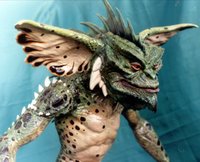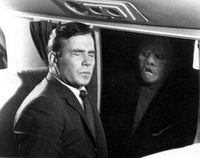
Friday, September 01, 2006
The Daily Hump: Gremlin
 Thanks to the 1984 film, society is pretty well educated on how to create an army of gremlins. First, you have to find yourself a mogwai. Dowse the mogwai with water and it'll asexually reproduce, replicating like a tribble. Then feed the resulting mogwai spawn after midnight, and voila, you have yourself a fine batch of Corey Feldman-certified Grade A gremlins.
Thanks to the 1984 film, society is pretty well educated on how to create an army of gremlins. First, you have to find yourself a mogwai. Dowse the mogwai with water and it'll asexually reproduce, replicating like a tribble. Then feed the resulting mogwai spawn after midnight, and voila, you have yourself a fine batch of Corey Feldman-certified Grade A gremlins. Of course, the pop cultural history of gremlins stretches much further back than the Reagan-era. Some of the more memorable gremlin moments include William Shatner's (speaking of tribbles) role as Bob Wilson in a "Nightmare at 20,000 Feet" or Bugs Bunny being harassed by his gremlin nemesis in 1943's "Falling Hare."
Of course, the pop cultural history of gremlins stretches much further back than the Reagan-era. Some of the more memorable gremlin moments include William Shatner's (speaking of tribbles) role as Bob Wilson in a "Nightmare at 20,000 Feet" or Bugs Bunny being harassed by his gremlin nemesis in 1943's "Falling Hare."The common element in both "Nightmare at 20,000 Feet" and "Falling Hare" is, of course, the plane. In fact, before Chris Columbus wrote Gremlins, gremlins were almost exclusively known for their penchant for aircraft sabotage. As Wikipedia notes
The concept of the Gremlins as responsible for sabotaging aircraft is first recorded among airmen of Britain's Royal Air Force during World War 2, in particular the men of the high altitude Photographic Reconnaissance Units (PRU) of RAF Benson, Wick and St Eval. The story attempted to explain the accidents which often occurred during their flights.
 But the etymology of the word is a bit of a mystery.
But the etymology of the word is a bit of a mystery.It's theorized that gremlin is a blend of gruaimín and goblin. In Irish, a gruaimín is a sort of mischievous imp (from Middle Irish gruaim, gloom, surliness). The word goblin was first recorded in the 16th century, although the OED notes that in the 12th century "Ordericus Vitalis mentions Gobelinus as the popular name of a spirit which haunted the neighbourhood of Évreux." The OED hypothesizes the word may have its root in a Greek word meaning "wicked spirits invoked by rogues."
However, the more intriguing theory is that the word gremlin comes from the English family name Fremlin. The Fremlins ran their own brewery whose beer was supposedly very popular among the RAF pilots and it's not much of a stretch to imagine drunk pilots blaming their planes' mechanical failures on invisible mischievous creatures.
Gremlins [Wikipedia]
goblin [OED]
gremlin [The American Heritage® Dictionary of the English Language, Fourth Edition]
The Fremlin Family Name [Fremlin.de]
Labels: Irish Gaelic, The Daily Hump
:: posted by David, 8:44 AM
2 Comments:
I direct your attention to the Wikipedia entry. If they can't answer, then no one can.
Actually here.
It doesn't give an etymology, but perhaps it has something to do with the fact that the design was first sketched on the back of a barfbag while Richard Teague was flying to Detroit--again, the whole gremlin/plane thing.
It doesn't give an etymology, but perhaps it has something to do with the fact that the design was first sketched on the back of a barfbag while Richard Teague was flying to Detroit--again, the whole gremlin/plane thing.
